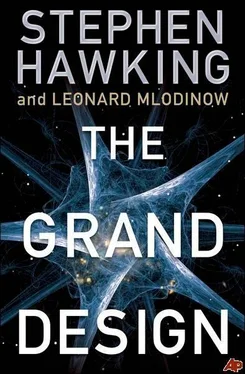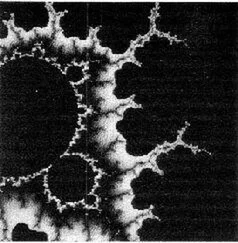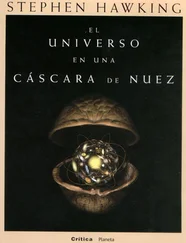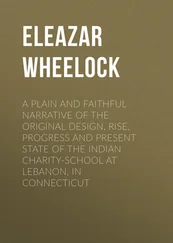Hundreds of years ago people thought the earth was unique, and situated at the center of the universe. Today we know there are hundreds of billions of stars in our galaxy, a large percentage of them with planetary systems, and hundreds of billions of galaxies. The results described in this chapter indicate that our universe itself is also one of many, and that its apparent laws are not uniquely determined. This must be disappointing for those who hoped that an ultimate theory, a theory of everything, would predict the nature of everyday physics. We cannot predict discrete features such as the number of large space dimensions or the internal space that determines the physical quantities we observe (e.g., the mass and charge of the electron and other elementary particles). Rather, we use those numbers to select which histories contribute to the Feynman sum.
We seem to be at a critical point in the history of science, in which we must alter our conception of goals and of what makes a physical theory acceptable. It appears that the fundamental numbers, and even the form, of the apparent laws of nature are not demanded by logic or physical principle. The parameters are free to take on many values and the laws to take on any form that leads to a self-consistent mathematical theory, and they do take on different values and different forms in different universes. That may not satisfy our human desire to be special or to discover a neat package to contain all the laws of physics, but it does seem to be the way of nature.
There seems to be a vast landscape of possible universes. However, as we’ll see in the next chapter, universes in which life like us can exist are rare. We live in one in which life is possible, but if the universe were only slightly different, beings like us could not exist. What are we to make of this fine-tuning? Is it evidence that the universe, after all, was designed by a benevolent creator? Or does science offer another explanation?


***

THE CHINESE TELL OF A TIME during the Hsia dynasty (ca. 2205-ca. 1782 BC) when our cosmic environment suddenly changed. Ten suns appeared in the sky. The people on earth suffered greatly from the heat, so the emperor ordered a famous archer to shoot down the extra suns. The archer was rewarded with a pill that had the power to make him immortal, but his wife stole it. For that offense she was banished to the moon.
The Chinese were right to think that a solar system with ten suns is not friendly to human life. Today we know that, while perhaps offering great tanning opportunities, any solar system with multiple suns would probably never allow life to develop. The reasons are not quite as simple as the searing heat imagined in the Chinese legend. In fact, a planet could experience a pleasant temperature while orbiting multiple stars, at least for a while. But uniform heating over long periods of time, a situation that seems necessary for life, would be unlikely. To understand why, let’s look at what happens in the simplest type of multiple-star system, one with two suns, which is called a binary system. About half of all stars in the sky are members of such systems. But even simple binary systems can maintain only certain kinds of stable orbits, of the type shown below. In each of these orbits there would likely be a time in which the planet would be either too hot or too cold to sustain life. The situation is even worse for clusters having many stars.
Our solar system has other “lucky” properties without which sophisticated life-forms might never have evolved. For example, Newton ’s laws allow for planetary orbits to be either circles or ellipses (ellipses are squashed circles, wider along one axis and narrower along another). The degree to which an ellipse is squashed is described by what is called its eccentricity, a number between zero and one. An eccentricity near zero means the figure resembles a circle, whereas an eccentricity near one means it is very flattened. Kepler was upset by the idea that planets don’t move in perfect circles, but the earth’s orbit has an eccentricity of only about 2 percent, which means it is nearly circular. As it turns out, that is a stroke of very good fortune.
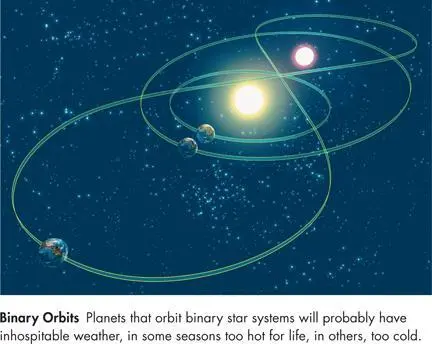
Seasonal weather patterns on earth are determined mainly by the tilt of the earth’s axis of rotation relative to the plane of its orbit around the sun. During winter in the Northern Hemisphere, for example, the North Pole is tilted away from the sun. The fact that the earth is closest to the sun at that time-only 91.5 million miles away, as opposed to around 94.5 million miles away from the sun in early July-has a negligible effect on the temperature compared with the effect of its tilt. But on planets with a large orbital eccentricity, the varying distance from the sun plays a much larger role. On Mercury, for example, with a 20 percent eccentricity, the temperature is over 200 degrees Fahrenheit warmer at the planet’s closest approach to the sun (perihelion) than when it is at its farthest from the sun (aphelion). In fact, if the eccentricity of the earth’s orbit were near one, our oceans would boil when we reached our nearest point to the sun, and freeze over when we reached our farthest, making neither winter nor summer vacations very pleasant. Large orbital eccentricities are not conducive to life, so we are fortunate to have a planet for which orbital eccentricity is near zero.
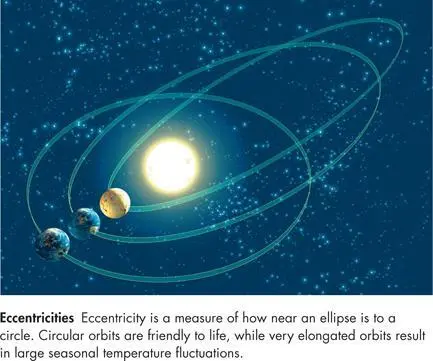
We are also lucky in the relationship of our sun’s mass to our distance from it. That is because a star’s mass determines the amount of energy it gives off. The largest stars have a mass about a hundred times that of our sun, while the smallest are about a hundred times less massive. And yet, assuming the earth-sun distance as a given, if our sun were just 20 percent less or more massive, the earth would be colder than present-day Mars or hotter than present-day Venus.
Traditionally, given any star, scientists define the habitable zone as the narrow region around the star in which temperatures are such that liquid water can exist. The habitable zone is sometimes called the “Goldilocks zone,” because the requirement that liquid water exist means that, like Goldilocks, the development of intelligent life requires that planetary temperatures be “just right.” The habitable zone in our solar system, pictured above, is tiny. Fortunately for those of us who are intelligent life-forms, the earth fell within it!
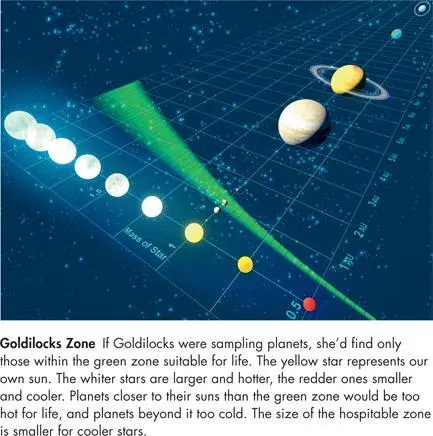
Newton believed that our strangely habitable solar system did not “arise out of chaos by the mere laws of nature.” Instead, he maintained, the order in the universe was “created by God at first and conserved by him to this Day in the same state and condition.” It is easy to understand why one might think that. The many improbable occurrences that conspired to enable our existence, and our world’s human-friendly design, would indeed be puzzling if ours were the only solar system in the universe. But in 1992 came the first confirmed observation of a planet orbiting a star other than our sun. We now know of hundreds of such planets, and few doubt that there exist countless others among the many billions of stars in our universe. That makes the coincidences of our planetary conditions-the single sun, the lucky combination of earth-sun distance and solar mass-far less remarkable, and far less compelling as evidence that the earth was carefully designed just to please us human beings. Planets of all sorts exist. Some-or at least one-support life. Obviously, when the beings on a planet that supports life examine the world around them, they are bound to find that their environment satisfies the conditions they require to exist.
Читать дальше
